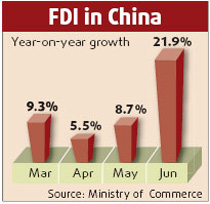China's key inflation indicator surged to an 11-year high of 6.9 percent in November on food price increases, triggering fear the ongoing inflation will become more evident.
In the meantime, the country reported a surplus of 26.28 billion U.S. dollars in foreign trade for November, according to figures released by the General Administration of Customs later on Tuesday.
The November surplus was less than the record 27.05 billion U.S. dollars recorded in October, indicating that the government's macro control efforts to rein in trade surplus have begun to pay off.
While it still takes time to slow its sizzling exports, the task for the country to tame inflation seems more arduous at present.
"The latest figure indicates accelerating inflation pressure," NBS chief economist Yao Jingyuan told Xinhua. He said price jumps for foodstuffs, which have a 33 percent weighting in China's CPI, and oil price increases were the major driving forces behind the rise.
Food prices ballooned 18.2 percent in November from a year earlier, compared with 17.6 percent in October.
The bureau said food prices drove up the November CPI figure by 5.94 percentage points.
Grain prices rose 6.6 percent over the same period last year, while cooking oil prices increased 35 percent. Pork prices, blamed for the recent increase in CPI figures, soared 56 percent.
Non-food prices, however, rose only 1.4 percent, though higher than 1.1 percent in October, according to the bureau.
November was the ninth consecutive month the CPI had risen by more than three percent, the government-set alarm level for the current year.
"The CPI figure will remain at a high level in the coming several months," said Tang Min, the chief economist with the Asian Development Bank (ADB) mission in China. He added pork prices were not expected to fall until the end of the breeding cycle.
China has been subsidizing pig breeders and insuring female pigs to boost farmers' enthusiasm for raising more of the animals. The country was hit by a pork shortfall that was triggered by a pig cull following the outbreak of blue-ear disease.
However, Lu Zhongyuan, director of the Macroeconomic Research Institute of the Development Research Center of the State Council, said the country was still short of pork as farmers remained reluctant to raise more of the animals for fear that they would lose a fortune in future pork price drops.
The country's pork prices picked up again in November despite a moderate decline in September and October.
In the period between January and November, the accumulative increase of the main inflation indicator stood at 4.6 percent, the bureau said.
China's consumer price index was forecast to be around 4.7 percent for the year. It would be the highest yearly figure since 1997, the NBS' Yao said. The previous record for annual CPI increase was 8.3 percent in 1996.
The ADB's Tang said the country would have to accelerate its tightening moves. "The central bank will raise interest rates once or twice in the future and they will act very soon."
The central bank announced on Saturday it would raise the reserve-requirement ratio for commercial banks for a 10th time this year. It had also raised interest rates five times.
Amid efforts to tame inflation, China announced in September it would freeze prices of major consumer products subject to government controls or regulations.
The country was forced, however, to raise prices of gasoline, diesel and aviation kerosene by nearly 10 percent from Nov. 1 amid a supply shortfall.
It said the oil price increase contributed only 0.05 percentage points to the monthly consumer price index.
To cap price rises, China also said it would boost production of necessities and major agricultural products, clampdown on price rigging and extend allowances to low-income residents.
The November consumer price index (CPI) figure was also higher than the prevalent market prediction of 6.6 percent. Some analysts have started to worry that China's economy, which has achieved the rare double of high growth and low inflation over the past 10 years, may have to be seriously bothered by the spectrum of inflation.
Its inflation rate was kept within a desirable range over the past few years at 1.2 percent in 2003, 3.9 percent in 2004, 1.8 percent in 2005 and 1.5 percent in 2006. But things changed substantially this year.
The NDRC's Bi said China was under great pressure to curb price rises in 2008. "It is really a big challenge ahead."
Analysts added China would have to revise its inflation target to a higher level for 2008, and that a target below the yearly figure for the whole of 2007 would be desirable.
(Xinhua News Agency December 11, 2007)


